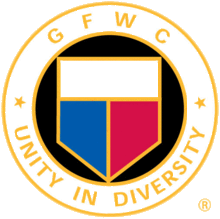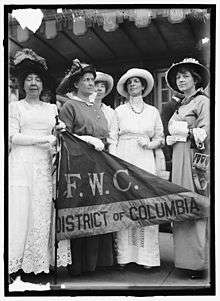General Federation of Women's Clubs
 | |
| Founded | 1890 |
|---|---|
| Headquarters | Washington, D.C. |
| Website |
www |
The General Federation of Women's Clubs (GFWC), founded in 1890 during the Progressive Movement, is a federation of over 3,000 local women's clubs which promote civic improvements through volunteer service. Many of its activities and service projects are done independently by local clubs through their communities or GFWC's national partnerships. GFWC maintains nearly 100,000 members[1] throughout the United States and internationally. GFWC remains one of the world's largest and oldest nonpartisan, nondenominational, women's volunteer service organizations. [2]
History
The GFWC was founded by Jane Cunningham Croly, a leading New York journalist. In 1868 she helped found the Sorosis club for professional women. It was the model for the nationwide GFWC in 1890.

In 1889 Mrs. Croly organized a conference in New York that brought together delegates from 61 women's clubs. The women formed a permanent organization in 1890 with Charlotte Emerson Brown as its first president.[3] In 1901 it was granted a charter by Congress. Dietz proclaimed, "We look for unity, but unity in diversity" and that became the GFWC motto. Southern white women played a central role in the early years.[4]
Local women's clubs initially joined the General Federation directly but later came into membership through state federations that began forming in 1892. The GFWC also counts international clubs among its members.
In 1900, the GFWC met in Milwaukee, and Josephine Ruffin, a black journalist, tried to attend as a representative of three Boston organizations – the New Era Club, the New England Woman's Club and the New England Woman's Press Club. Southern women led by president Rebecca Douglas Lowe, a Georgia native, told Ruffin that she could be seated as a representative of the two white clubs but not the black one. She refused on principle and was excluded from the proceedings. These events became known as "The Ruffin Incident" and were widely covered in newspapers around the country, most of whom supported Ruffin. At the same time, Lowe and the Georgia Education League provided kindergartens for black children in Georgia.[5][6][7]
In a time when women's rights were limited the State Federation chapters held grassroots efforts to make sure the woman's voice was heard. Through monthly group meetings, to annual charter meetings, women of influential status within their communities could have their feelings heard. They were able to meet with state officials in order to have a say in community events. Until the right to vote was granted, these women's clubs were the best outlet for women to be heard and taken seriously.
Women's clubs spread very rapidly after 1890, taking up some of the slack left by the decline of the WCTU and the temperance movement. Local clubs at first were mostly reading groups focused on literature, but increasingly became civic improvement organizations of middle-class women meeting in each other's homes weekly. To The clubs avoided controversial issues that would divide the membership, especially religion and the prohibition issue. In the South and East, suffrage was also highly divisive, while there was little resistance to it among clubwomen in the West. In the Midwest, clubwomen had first avoided the suffrage issue out of caution, but after 1900 increasingly came to support it. [8]

Representative activities
Historian Paige Meltzer puts the GFWC in the context of the Progressive Movement, arguing that its policies:
- built on Progressive-era strategies of municipal housekeeping. During the Progressive era, female activists used traditional constructions of womanhood, which imagined all women as mothers and homemakers, to justify their entrance into community affairs: as "municipal housekeepers," they would clean up politics, cities, and see after the health and wellbeing of their neighbors. Donning the mantle of motherhood, female activists methodically investigated their community's needs and used their "maternal" expertise to lobby, create, and secure a place for themselves in an emerging state welfare bureaucracy, best illustrated perhaps by clubwoman Julia Lathrop's leadership in the US Children's Bureau. As part of this tradition of maternal activism, the Progressive-era General Federation supported a range of causes from the pure food and drug administration to public health care for mothers and children to a ban on child labor, each of which looked to the state to help implement their vision of social justice.[9]
Kansas was a representative state, as the women's clubs joined with local chapters of the WCTU and other organizations to deal with social issues. The clubs continued to feature discussions of current literature, culture, and civic events, but they also broadened to include public schools, local parks, sanitation, prostitution, and protection of children. [10]
Paula Watson has shown that across the country the clubs supported the local Carnegie public library, as well as traveling libraries for rural areas. They promoted state legislation to fund and support libraries, especially to form library extension programs. GFWC affiliates worked with the American Library Association, state library associations, and state library commissions and gave critical support to library education programs at the universities.[11]
Many clubs were especially concerned with uplifting the neglected status of American Indians. They brought John Collier into the forefront of the debate when they appointed him the research agent for the Indian Welfare Committee in 1922. The GFWC took a leadership role in opposing assimilation policies, supporting the return of Indian lands, and promoting more religious and economic independence.[12] For example, Southwestern clubs help support the Museum of Northern Arizona (MNA) and became advocates and consumers for authentic Native American arts and crafts.[13] Even more important, in Western states GFWC affiliates cooperated with Collier when he served (1933-45) as the New Deal's Commissioner for Indian affairs, in his campaign to reverse federal policies designed to assimilate Indians into the national culture.
The membership peaked at 850,000 in 16,000 clubs in 1955, and has declined to about 100,000 in the 21st century as middle class women have moved into the public mainstream. During the Cold War era the GFWC promoted the theme that American women had a unique ability to preserve world peace while strengthening the nation internally through local, national, and international community activism.[14] The remaining 100,000 members are older now, and have less influence in national affairs.[15] The affiliated clubs in every state and more than a dozen countries work locally:
- to support the arts, preserve natural resources, advance education, promote healthy lifestyles, encourage civic involvement, and work toward world peace and understanding.[16]
In 2009, GFWC members raised over $39 million on behalf of more than 110,000 projects, and volunteered more than 4.1 million hours in the communities where they live and work.[17]
Notable clubwomen
|
|
See also
- Nineteenth Amendment to the United States Constitution
- Ossoli Circle
- Sorosis
- Women's club (United States)
References
- ↑ "Who We Are". GFWC.org. Retrieved 22 January 2015.
- ↑ Blair 1998
- ↑ "Charlotte Emerson Brown - American clubwoman". Encyclopedia Britannica.
- ↑ General Federation of Women's Clubs (1910). Biennial of the General Federation of Women's Clubs: Official Proceedings. ... .no. p. 446.
- ↑ Mary Jane Smith, "The Fight to Protect Race and Regional Identity within the General Federation of Women's Clubs, 1895-1902." Georgia Historical Quarterly (2010): 479-513 in JSTOR
- ↑ "Race Discrimination", Congregationalist 85:24, 1900 June 14.
- ↑ "Color-Line in Women's Clubs", Congregationalist 86:6, 1901 February 9
- ↑ Stephen M. Buechler, The Transformation of the Woman Suffrage Movement: The Case of Illinois, 1850-1920 (1986) pp 154-57
- ↑ Paige Meltzer, "The Pulse and Conscience of America" The General Federation and Women's Citizenship, 1945-1960," Frontiers: A Journal of Women Studies (2009), Vol. 30 Issue 3, p52-76. online
- ↑ June O. Underwood, "Civilizing Kansas: Women's Organizations, 1880-1920," Kansas History (1984) 7#4 pp 291-306.
- ↑ Paula D. Watson, "Founding mothers: The contribution of women's organizations to public library development in the United States." Library Quarterly (1994) pp: 233-269 in JSTOR.
- ↑ Karin L. Huebner, "An Unexpected Alliance: Stella Atwood, the California Clubwomen, John Collier, and the Indians of the Southwest, 1917–1934," Pacific Historical Review (2009) 78#3 pp: 337-366 in JSTOR
- ↑ Jennifer McLerran, "Clubwomen, Curators and Traders," American Indian Art Magazine (2011) 36#4 pp 54-92
- ↑ Meltzer, "The Pulse and Conscience of America" The General Federation and Women's Citizenship, 1945-1960,"
- ↑ Blair, 1998
- ↑ From the GFWC Website
- ↑ "GFWC 2009-2010 Annual Report" (PDF). Retrieved 2012-04-09.
Further reading
- Blair, Karen J. "General Federation of Women's Clubs," in Wilma Mankiller et al. eds., The Readers Companion to U.S. Women's History (1998) p 242
- Houde, Mary Jean. Reaching Out: A Story of the General Federation of Women's Clubs (Washington, DC: General Federation of Women's Clubs, 1989). ISBN 978-0-916371-08-1
- Meltzer, Paige. "The Pulse and Conscience of America" The General Federation and Women's Citizenship, 1945-1960," Frontiers: A Journal of Women Studies (2009), Vol. 30 Issue 3, p52-76. online
- White, Kristin Kate, “Training a Nation: The General Federation of Women’s Clubs’ Rhetorical Education and American Citizenship, 1890–1930” (PhD dissertation, Ohio State University, 2010). DA3429649.
External links
| Wikimedia Commons has media related to General Federation of Women's Clubs. |